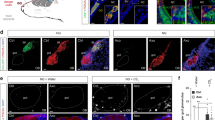Abstract
The Grueneberg ganglion is one of the peripheral parts of the olfactory sensory system that specializes in detecting life-threatening stimuli. This article focuses on the chemoreceptors of ganglion neurons and their associated signaling pathways, which together provide a multimodal receptor function. The molecular organization of the receptor apparatus of neurons of this organ undergoes significant changes during ontogenesis, providing a shift in specialization in the direction from thermoreception in the neonatal period to chemoreception at later stages of development.


Similar content being viewed by others
REFERENCES
H. Gruneberg, Z. Anat. Entwicklungsgesch. 140 (1), 39 (1973).
J. Fleischer and H. Breer, Histol. Histopathol. 25 (7), 909 (2010).
J. Brechbuhl, M. Klaey, and M. C. Broillet, Science 321 (5892), 1092 (2008).
S. H. Fuss, M. Omura, and P. Mombaerts, Eur. J. Neurosci. 22 (10), 2649 (2005).
T. Tachibana, N. Fujiwara, and T. Nawa, Arch. Histol. Cytol. 53 (2), 147 (1990).
J. Fleischer, N. Hass, K. Schwarzenbacher, et al., Histochem. Cell Biol. 125 (4), 337 (2006).
J. Fleischer, K. Schwarzenbacher, S. Besser, et al., J. Neurochem. 98 (2), 543 (2006).
S. H. Fuss, M. Omura, and P. Mombaerts, Eur. J. Neurosci. 22 (10), 2649 (2005).
D. Roppolo, V. Ribaud, V. P. Jungo, et al., Eur. J. Neurosci. 23 (11), 2887 (2006).
M. J. Storan and B. Key, J. Comp. Neurol. 494 (5), 834 (2006).
R. Bumbalo, M. Lieber, L. Schroeder, et al., Cell. Mol. Neurobiol. 37 (4), 729 (2017).
R. E. Cockerham, A. C. Puche, and S. D. Munger, PLoS One 4 (2), e4657 (2009).
F. Chehrehasa, A. Jacques, J. A. St John, and J. A. K. Ekberg, Brain Res. 1688, 65 (2018).
J. Brechbuhl, M. Klaey, F. Moine, et al., Front. Neuroanat. 8, 87 (2014).
N. Falk, M. Losl, N. Schroder, and A. Giesl, Cells 4 (3), 500 (2015).
H. Breer, J. Fleischer, and J. Strotmann, Cell Mol. Life Sci. 63 (13), 1465 (2006).
J. Fleischer, K. Schwarzenbacher, S. Besser, et al., J. Neurochem. 98 (2), 543 (2006).
J. Fleischer, K. Schwarzenbacher, and H. Breer, Chem. Senses 32 (6), 623 (2007).
R. R. Gainetdinov, M. C. Hoener, and M. D. Berry, Pharmacol Rev. 70 (3), 549 (2018).
F. Moine, J. Brechbuhl, and M. Nenniger Tosato, et al., BMC Biol 16, 12 (2018).
J. Chandrashekar, M. A. Hoon, N. J. Ryba, and C. S. Zuker, Nature 444 (7117), 288 (2006).
H. J. Fulle, R. Vassar, D. C. Foster, et al., Proc. Natl. Acad. Sci. U. S. A. 92 (8), 3571 (1995).
F. Zufall and S. D. Munger, Mol. Cell. Biochem. 334 (1), 191 (2010).
M. Kuhn, Physiol. Rev. 96 (2), 751 (2016).
K. Mamasuew, N. Hofmann, V. Kretzschmann, et al., Neurosignals 19 (4), 198 (2011).
E. V. Bigdai, Ross. Fiziol. Zh. im. I. M. Sechenova 90 (6), 710 (2004).
C. Y. Su, K. Menuz, and J. R. Carlson, Cell 139 (1), 45 (2009).
C. Y. Liu, S. E. Fraser, and D. S. Koos, J. Comp. Neurol. 516 (1), 36 (2009).
J. Zhang, R. Pacifico, D. Cawley, et al., J. Neurosci. 33 (7):3228, (2013).
G. T. Wong, K. S. Gannon, and R. F. Margolskee, Nature 381 (6585), 796 (1996).
A. Perez-Gomez, B. Stein, T. Leinders-Zufall, and P. Ghamero, Front. Neuroanat. 8, 135 (2014).
J. Fleischer, K. Mamasuew, and H. Breer, Histochem. Cell Biol. 131 (1), 75-88 (2009).
W. Lin, J. Arellano, B. Slotnick, and D. Restrepo, J. Neurosci. 24 (14), 3703 (2004).
K. Mamasuew, N. Hofmann, H. Breer, and J. Fleischer, Chem. Senses 36 (3), 271 (2011).
W. Hanke, K. Mamasuew, M. Biel, et al., Neurosci. Lett. 539, 38 (2013).
S. D. Munger, T. Leinders-Zufall, and F. Zufall, Annu. Rev. Physiol. 71, 115 (2009).
J. Brechbuhl, F. Moine, M. N. Tosato, et al., Front. Neurosci. 9, 253 (2015).
Y. C. Chao, J. Fleischer, and R. B. Yang, EMBO J. 37 (1), 39 (2018).
E. M. Norlin, V. Vedin, S. Bohm, and A. Berghard, J. Neurochem. 93 (6), 1594 (2005).
K. Mamasuew, H. Breer, and J. Fleischer, Eur. J. Neurosci. 28 (9), 1775 (2008).
R. Bumbalo, M. Lieber, E. Lehmann, et al., Neuroscience 366, 149 (2017).
A. Schmid, M. Pyrski, M. Biel, et al., J. Neurosci. 30 (22), 7563 (2010).
J. Brechbuhl, F. Moine, and M. C. Broillet, Front. Behav. Neurosci. 7, 193 (2013).
C. Y. Liu, S. E. Fraser, and D. S. Koos, J. Comp. Neurol. 516 (1), 36 (2009).
K. Mamasuew, S. Michalakis, H. Breer, et al., Cell. Mol. Life Sci. 67 (11), 1859 (2010).
C. Y. Liu, C. Xiao, S. E. Fraser, et al., J. Neurophysiol. 108 (5), 1318 (2012).
S. J. Kleene, Chem. Senses 33 (9), 839 (2008).
B. Tazir, M. Khan, P. Mombaerts, and X. Grosmaitre, Eur. J. Neurosci. 43 (5), 608 (2016).
Funding
This work was carried out with the financial support of the Program of Fundamental Scientific Research of State Academies for 2014–2020 (GP-14, section 63).
Author information
Authors and Affiliations
Corresponding author
Ethics declarations
CONFLICT OF INTEREST
The authors declare that there is no conflict of interest.
COMPLIANCE WITH ETHICAL STANDARDS
This paper does not describe studies using humans and animals as objects.
Additional information
Translated by E. Puchkov
Abbreviations: GG, Grueneberg ganglion; OMP, olfactory marker protein; TAAR, trace amine-associated receptors.
Rights and permissions
About this article
Cite this article
Bigdai, E.V., Samoilov, V.O. & Sinegubov, A.A. The Mechanisms of Chemoreception and Thermoreception in the Grueneberg Ganglion. BIOPHYSICS 66, 91–97 (2021). https://doi.org/10.1134/S0006350921010139
Received:
Revised:
Accepted:
Published:
Issue Date:
DOI: https://doi.org/10.1134/S0006350921010139




